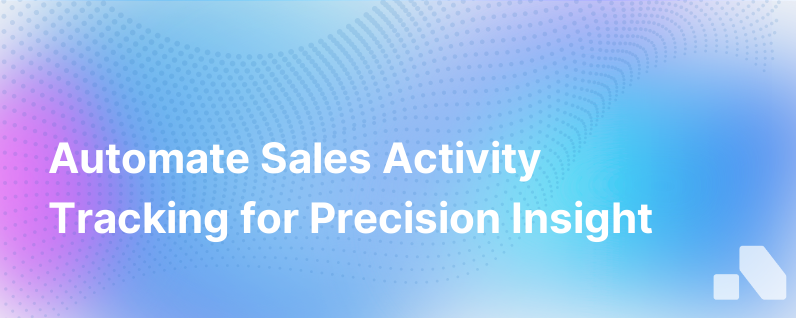How To Automatically Track Sales Activity Data
Published on July 6, 2023 by David Zhang
In the fiercely competitive realm of sales, efficiency and precision are paramount. Sales activity tracking provides clarity, enabling teams to refine their process and priorities. For B2B sales, it’s not just a question of how many calls or emails are made, but the quality of the conversations and the progression of a deal through the pipeline. However, traditional manual data entry is time-consuming and often rife with inaccuracies. Enter the age of automation, a veritable game-changer for systematically tracking sales activity, leading to improved sales outcomes and strategic insights.
Traditional Methods and Their Pitfalls Traditionally, sales activity data tracking has been a manual process: logging calls, emails, meetings, and follow-ups into CRM systems. This manual method is fraught with issues. The data is often incomplete or erroneous, and the time spent on manual entry encroaches on precious selling time. Moreover, manual entry doesn’t guarantee real-time data access, leading to potentially critical delays in decision-making.
Now, forward-thinking companies are turning to automated tools to capture, analyze, and leverage sales activity data effectively. Leveraging the right technology and processes can provide a holistic view of sales activities without the drawbacks of manual tracking.
The Advent of Automated Sales Activity Tracking Modern sales technology automates the collection and recording of myriad types of sales activity data. This encompasses traditional communication channels like email, phone, and meetings, as well as social interactions, proposal sent, contract negotiations, and more. Solutions like CRM automation, sales intelligence platforms, and AI-driven analytical tools carve a path into the future of sales productivity. Automatic tracking offers several pivotal advantages:
- Time-saving: Automation frees up sales reps to focus on what they do best—selling. The eliminating mundane data entry tasks alone boosts efficiency exponentially.
- Accuracy: With automated data capture, the information is more reliable, providing a true reflection of sales activities.
- Real-time Insights: Automated tools often offer real-time data, allowing for agile decision-making and responsiveness to market dynamics.
- Scalability: As sales efforts intensify and the volume of data grows, automated systems can scale much more effectively than human counterparts.
Implementing Automatic Sales Activity Tracking To embrace automated tracking, one should follow a strategic implementation plan:
-
Identify KPIs and Metrics: Define the Key Performance Indicators (KPIs) and specific metrics important to your sales process. This could include the number of calls made per day, email open rates, or conversion rates at different stages of the sales funnel.
-
Select a Robust CRM Platform: Choose a Customer Relationship Management (CRM) system that integrates well with automation tools. Modern CRMs like Salesforce, HubSpot, or Zoho can automate various tracking tasks, from call logging to email interaction.
-
Integrate Sales Communication Tools: Sync your sales communication platforms with your CRM. Tools like Gong, Outreach, or Salesloft can track phone calls, emails, and social selling activities, automatically recording them into the CRM.
-
Utilize Sales Intelligence Software: Implement sales intelligence solutions that gather data from multiple sources to provide a comprehensive view of customer interactions. A platform like Aomni helps with real-time account research and competitive insights.
-
Leverage AI and Machine Learning: Incorporate AI tools that can predict and prescribe sales actions based on historical data patterns. These can be essential in prioritizing leads and guiding reps on next steps.
-
Continuous Training: Ensure ongoing training and support for your sales team to help them understand the benefits and usage of automated tracking tools.
-
Adopt Analytics and Dashboarding: Implement advanced analytics and dashboarding capabilities for a visual representation of sales activity data. This can unearth trends, patterns, and areas needing improvement.
-
Ensure Data Security: With the rise in automated tracking arises the need for strict data security. Be sure to implement secure methods of data collection and storage to comply with regulations like GDPR.
-
Iterate and Optimize: Regularly review the automated tracking system’s performance, and make adjustments based on user feedback and data insights.
-
Encourage Adoption: Lead by example and promote a culture that values data integrity and operational efficiency.
Case in Point: The Power of Automation Here’s an example scenario: A sales representative, let’s call her Jane, is on a call with a prospect. As Jane discusses potential solutions, her CRM system, integrated with an AI-driven sales platform, is automatically logging the call's details. It records its duration, and – using natural language processing – picks up on keywords that hint at the prospect’s interests and pain points. It immediately schedules a follow-up task for Jane, proposing the best time to contact the prospect again based on historical data. Simultaneously, it triggers content recommendations for Jane to include in her next email - all of this happening without requiring Jane to manually input a single piece of data. This is the true potential of automated sales activity tracking.
In conclusion, the integration of automated sales activity tracking systems marks a significant before-and-after in sales productivity and effectiveness. Embracing these tools not only saves time but can also facilitate more informed business strategies. The key to success is carefully selecting the right mix of tools, aligning them with your KPIs, and fostering a data-centric sales culture. As we evolve with technology, sales activity data's accuracy, timeliness, and relevance will increasingly be the differentiators for leading sales organizations.